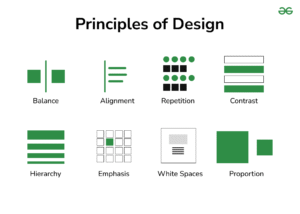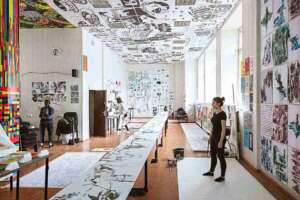Understanding the fundamentals of art and design is essential for anyone pursuing a career in the field of design. Whether you’re a novice or an experienced artist, having a solid grasp of these concepts will significantly enhance your design work. We’ll examine the essential aspects of design and art. We’ll provide a list of renowned institutions such as Savannah College of Art and Design, Ringling College of Art and Design, Museum of Arts and Design, Otis College of Art and Design, Art and Design High School, as well as Massachusetts College of Art and Design, which can help you through the process of acquiring these abilities.
The Elements of Art

The art elements are the fundamental elements used to create works of art. They form the basis for all artwork that includes sculptures, paintings, and digital art. Knowing these elements will help artists express their ideas more efficiently and effectively. The most important components of artwork are
1. Line
Lines are the fundamental element of art, and act as a guide that the viewer can follow. Lines can be long, straight, curly, thin, thick, short, long, or varied in various ways. They define forms, make texture, and may even depict the movement of the artwork. Lines are frequently employed to communicate emotion, structure, and even direction.
2. Shape
Shapes are two-dimensional shapes that are created by lines. They may be geometric (like circles and squares) and organic (like the forms that are found within nature). Shapes are used to define the arrangement and structure of a composition. They also give the structure needed for other elements to work within.
3. Color
Color is among the elements that express the emotion of art. It can evoke emotions, convey mood, and draw attention to the viewer. Colors are classified as primary (red, blue, yellow, and green) and secondary (orange and green), tertiary (purple, purple), and quaternary (colors created by mixing secondary and primary colors). Artists employ color theory to choose colors that can increase the overall impact of the piece.
4. Texture
The term “texture” refers to the texture of an art work. It could be real (felt physical) or implicit (suggested by visual). For instance, rough textures could bring a sense of ruggedness, and a smooth surface may suggest a calmness or softness. Artists manipulate texture to add the illusion of depth, contrast, and a sense of excitement within their art.
5. Value
Value is the amount of light or darkness in an object or a tone. It can create an atmosphere of contrast, depth, and emphasis in artwork. The high contrast can make certain elements stand out, whereas slight variations in the value could be a sign of shadow, light, or even volume.
6. Space
Space refers to the space surrounding and inside objects within an artwork. It could have a positive meaning (occupied with objects) and a negative meaning (the space surrounding the objects). Space influences the balance and composition of an art piece, leading the eye of the viewer, and assisting in giving a sense of perception or depth.
7. Form
Form is the 3-dimensional alternative to shape. While shape is flat, it has volume and depth. The majority of artists use forms for sculptures or three-dimensional digital artwork. These elements enable the viewer to experience art in several dimensions.
The Principles of Design

When you have a grasp of the basic elements of art, the concepts of design come into play to arrange those elements into a cohesive and visually appealing composition. The principles of design assist artists in arranging their elements to effectively convey meaning and trigger emotions. The basic elements that define design include:
1. Balance
Balance is the term used to describe the visual weight distribution in a piece. It could be the case of symmetry (where the two sides of an artwork are the same), asymmetrical (where the elements are balanced through their weight in the visual), or radial (where elements radiate outwards from a central location). Balance in art assures that the eye of the viewer is drawn equally across the artwork.
2. Contrast
Contrast is the distinction between two elements, like dark versus light and smooth versus rough or small versus large. This concept helps to create an interest and focal points within the art. If a piece is not contrasted, it may appear dull and lacking energy.
3. Emphasis
The emphasis is the idea of creating a focal point in the work. It draws the attention of the viewer to a specific part of the work. This is accomplished through using contrasting patterns, colors, or by placing an object within the composition. The emphasis gives the artwork meaning and order.
4. Movement
Moving refers to how the eye of the viewer moves across the artwork. Artists make use of motion to guide the viewer from one aspect to the next and create a sense of movement or progress. The movement can be literal, such as the depiction of a subject moving, or it could be implied by the arrangement of shapes, lines, or even colors.
5. Pattern
Pattern refers to the repetition of certain elements, such as lines, shapes, or colors. It can create a rhythm in artworks and can be utilized to create the appearance of texture and create a sense of unity. Repetition of a motif over and over again creates a unified look, as well as irregular patterns provide visual interest.
6. Rhythm
Rhythm refers to the repetition of visual elements that create an impression of organized motion. Like music, a rhythm in art carries viewers’ eyes to move from one area of the piece towards the next. It creates a sense of consistency and flow in the work.
7. Unity
Unity refers to the cohesion of an artwork. It is the guiding principle that ensures that all components and the principles function in perfect harmony. The goal of unity can be accomplished through repeating colors, shapes, or textures. This ensures that the composition is complete and well-organized.
Notable Art and Design Schools and Institutions

If you’re seeking to learn about design and art, many top institutions offer comprehensive training in both the components of art and the underlying principles of design. Here are a few of them:
Savannah College of Art and Design
The Savannah College of Art and Design (SCAD) is well-known for its broad courses in design, fine arts, along digital media. The SCAD curriculum helps students gain a deeper knowledge of both the fundamentals of art as well as the fundamentals of design. Students are able to be a part of a team of professional designers and artists from a variety of disciplines and develop their skills in a setting that encourages innovation and creativity. Savannah College of Art and Design provides a variety of degrees in fields including graphic design, fashion design, architecture, and many other fields.
Ringling College of Art and Design

Ringling College of Art and Design is a leading institution that excels at developing the creative talents of its students. With a particular focus on the success of students, Ringling prepares its graduates for jobs in a variety of art fields. The program covers the fundamentals of design, art as well and visual storytelling. If you’re interested in graphic design, animation, and industrial design, Ringling College of Art and Design provides students with the necessary skills to compete in today’s competitive and creative world.
Museum of Arts and Design
The Museum of Arts and Design (MAD), located in New York, is not only an art museum, but it is also an institution that provides an array of educational opportunities for students of design and art. And the museum provides talks, workshops, and exhibits that look at the relationship between the fine and industrial arts. The museum also hosts events that explore the fundamentals of design and the fundamentals of art, offering an opportunity for inspiration and learning for artists who are aspiring.
Otis College of Art and Design

The campus is located in Los Angeles, and Otis College of Art and Design provides top-quality education in design and art. The college is committed to integrating elements of design and art principles in all its programmes. It is a place where students can experiment with different forms of artistic expression, ranging from traditional techniques to the latest digital media. Otis College fosters creativity while developing the skills required to succeed in the design and arts industry.
Art and Design High School
High school students who are interested in pursuing the field of design and art, Art and Design High School provides specialized courses that are focused on acquiring foundational artistic abilities. It is located in New York. This school helps students prepare for higher education in design and art by offering them experience-based learning and a rich curriculum that teaches the fundamentals of design and art.
Massachusetts College of Art and Design

The Massachusetts College of Art and Design (MassArt) is among the most prestigious and most renowned art colleges across the United States. The MassArt programs are designed to aid students in mastering the art elements and fundamentals of design. If you are interested in animation, fine arts, as well as industrial design, MassArt gives students a place that allows students to experiment and develop their artistic activities.
Conclusion
The elements of art and the principles of design are the foundations of all creative endeavors. Understanding these concepts is crucial for producing visually compelling and significant art. Institutions such as Savannah College of Art and Design, Ringling College of Art and Design, Museum of Arts and Design, Otis College of Art and Design, Art and Design High School along with Massachusetts College of Art and Design offer excellent opportunities for students to develop these skills and prepare themselves for jobs in the ever-changing world of design and art. When you understand and apply these principles, you will unleash your creativity and create artwork that is able to connect with viewers on the highest level.
FAQS
What are the fundamental elements of art?
The components of art are lines, shapes and texture, color value, space, and shape. These are the basic elements artists employ to construct and design their work.
What are the basic principles of design?
The basic principles of design are balance, contrast, focus, movement as well as rhythm, and unity. These principles aid in organizing all the components of artwork in order to make visually pleasing and powerful compositions.
What do I understand about the basic aspects of art and the principles of design?
You can study the basic elements and concepts of art through formal education at art schools like the Savannah College of Art and Design, Ringling College of Art and Design, as well as Massachusetts College of Art and Design, or through studying online courses, books, and hands-on training.
Which art school is the best to study design concepts?
Institutions such as the Savannah College of Art and Design, Otis College of Art and Design as well and Ringling College of Art and Design provide excellent programmes to help students understand the fundamentals of art as well as the fundamentals of design.
Why are the fundamentals of design so vital?
These principles assist artists structure and organize their work in a way that ensures that their work communicates clearly and captivates the viewers. They increase the impact and the meaning of artwork.











Leave a Comment